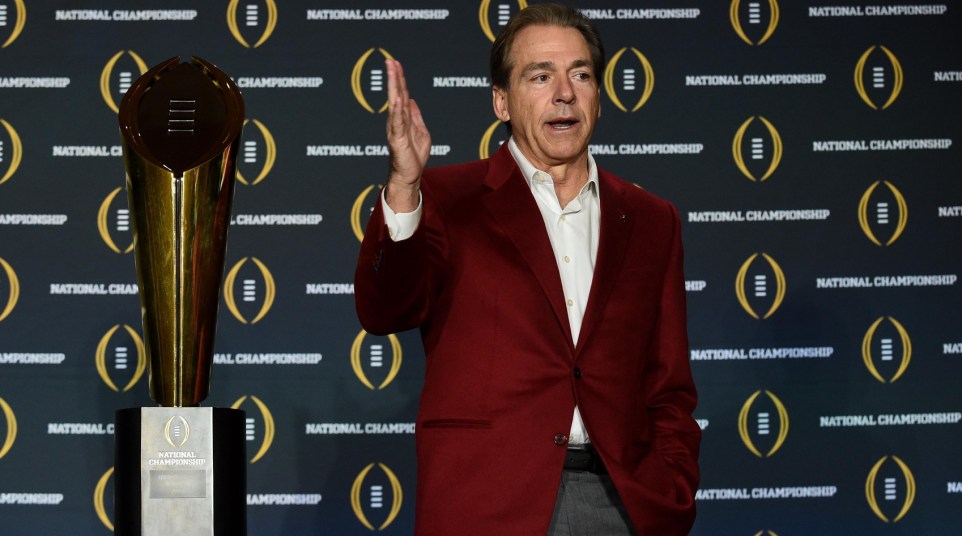
Nick Saban: The model of consistency
Before Nick Saban arrived at Alabama in 2007, the program went through a brutal stretch.
Mired in controversies and scandals, a school with a proud winning tradition didn’t routinely compete for SEC championships for more than a decade. Sure, the team won the SEC title in 1999 under head coach Mike DuBose. However, from 1996 until Saban arrived, coaching continuity didn’t really exist.
While DuBose’s squad went 10-3, Gene Stallings was the last coach to truly give Alabama fans hope for an SEC championship year in and year out. During his six years at the school, the Tide compiled a 62-25 record and won an SEC title (1992) while finishing as the SEC’s runner-up four times.
But even during Saban’s first season, prior NCAA infractions were discovered, leading to five of the 2007 squad’s seven wins being vacated and 16 others over the previous two seasons as well.
At this current time, long-time Alabama fans have gone from disillusioned to downright spoiled. Saban has brought four national championships back to Tuscaloosa and compiled a 100-18 overall record during his tenure (remember, five wins earned on the field do not count toward that total) at the Capstone. As a collegiate head coach, he is 191-60-1. For comparison purposes, LSU’s Les Miles has a career record of 140-53.
The SEC will include three coaches debuting as head coaches (Kirby Smart and Barry Odom) or as a head coach at a new school (Will Muschamp). Nine of the SEC’s 14 schools have coaches with three years or less at their current position.
Continuity isn’t everything. After all, Saban won a national championship by Year 3 at Alabama. That said, sustained success is a challenging task.
Former Nebraska head coach Tom Osborne certainly stands as a model of consistency, having never finished a season with a record worse than 9-3 during 25 years as a head coach. Osborne also won the national championship two times (and an additional USA Today national title) to go with 13 conference championships. Considered one of the greatest college football coaches of all-time, he still has three fewer championship rings than Saban. For all of his success, Osborne has a 12-13 career record in bowl games.
Urban Meyer is probably the only other current coach able to compare with Saban. Meyer has won three national championships and five conference championships. He, Saban and Pop Warner are the only college football coaches to win a major national championship at two different schools. Interestingly, Saban and Meyer sport 2-2 records when coaching against one another.
Perhaps the ultimate measure of sustained success for Saban comes from the man who coached in the same stadium. Paul “Bear” Bryant won six national championships as the head coach at Alabama, including 13 conference championships.
Saban is part of an exclusive club for winning the SEC championship at two different schools. The other member? Bryant, who also won an SEC title at Kentucky in 1950. It will be difficult for Saban to match Bryant, who won 232 games at Alabama and 323 during his career.
Still, Saban has the program in the midst of a historic run not seen since the days of Bryant. The team has been involved in the national championship conversation every year since Saban came to Tuscaloosa.
In fact, the last 10 national champions have either been Alabama or beaten Alabama, with the exception of 2013, the season in which Florida State beat the Auburn team that beat Alabama.
How incredible is that? Let’s rewind.
Even in his first season, Alabama nearly defeated eventual champion and Saban’s former school, LSU. Alabama led the game 34-27 late in the fourth quarter but eventually squandered its lead and lost 41-34. Saban had to settle for watching many of the players he recruited earn a championship ring under the tutelage of Les Miles.
By Saban’s second year, Alabama was more squarely at the forefront of the conversation. The team finished the regular season 12-0. However, it lost the SEC Championship Game to Florida, the team that would eventually win it all under Urban Meyer. The Tide lost to Meyer’s former team, Utah, in the Sugar Bowl to close out the season.
As previously noted, Alabama won the national title in Saban’s third season in charge of the program.
Despite finishing the season with 10 wins, 2010 was a disappointing season for the Tide. The team led rival Auburn 24-0 during the first half of the Iron Bowl but eventually lost the game 28-27. Auburn went on to win the national title.
Alabama bounced back to win back-to-back national crowns in 2011 and 2012.
The 2013 season was similar to that of 2008 because Alabama suffered a late-season loss to fall out of the National Championship picture and subsequently performed poorly in an anti-climactic bowl game. A 34-28 loss to Auburn catapulted the Tigers to the national title.
Alabama likely would have played eventual champion Florida State had they managed to win the Iron Bowl. Like 2008, the team closed out the season with a loss in the Sugar Bowl, this time to Oklahoma.
In 2014, Alabama lost 42-35 to Ohio State in the inaugural College Football Playoff. Ohio State went on to blow out Oregon 42-20 in the inaugural season of the College Football Playoff.
In 2015, Alabama reclaimed the throne after a blowout win against Michigan State in the College Football Playoff and a thrilling victory against Clemson in Glendale, Ariz.
With Saban still manning the controls, Alabama is sure to remain in the national championship conversation this season.
